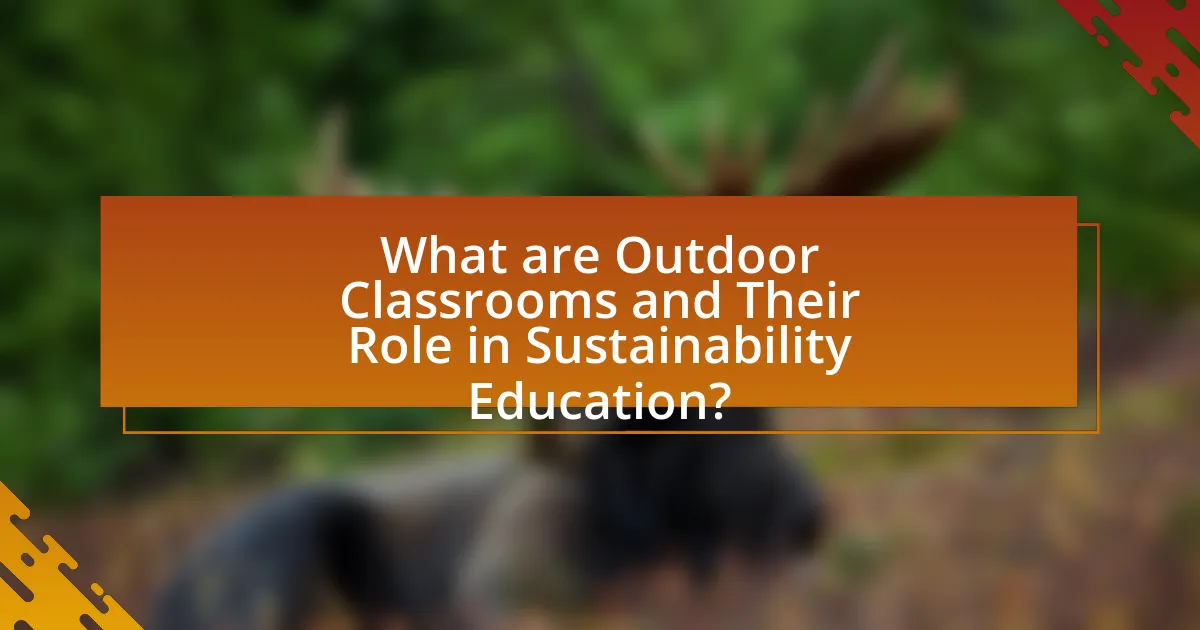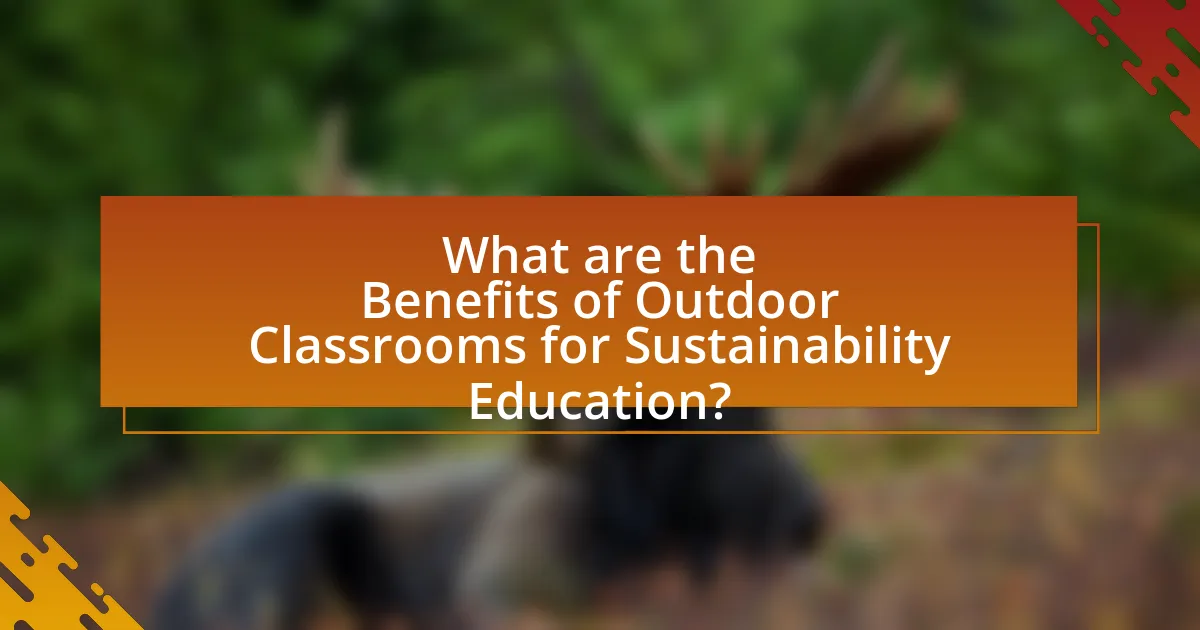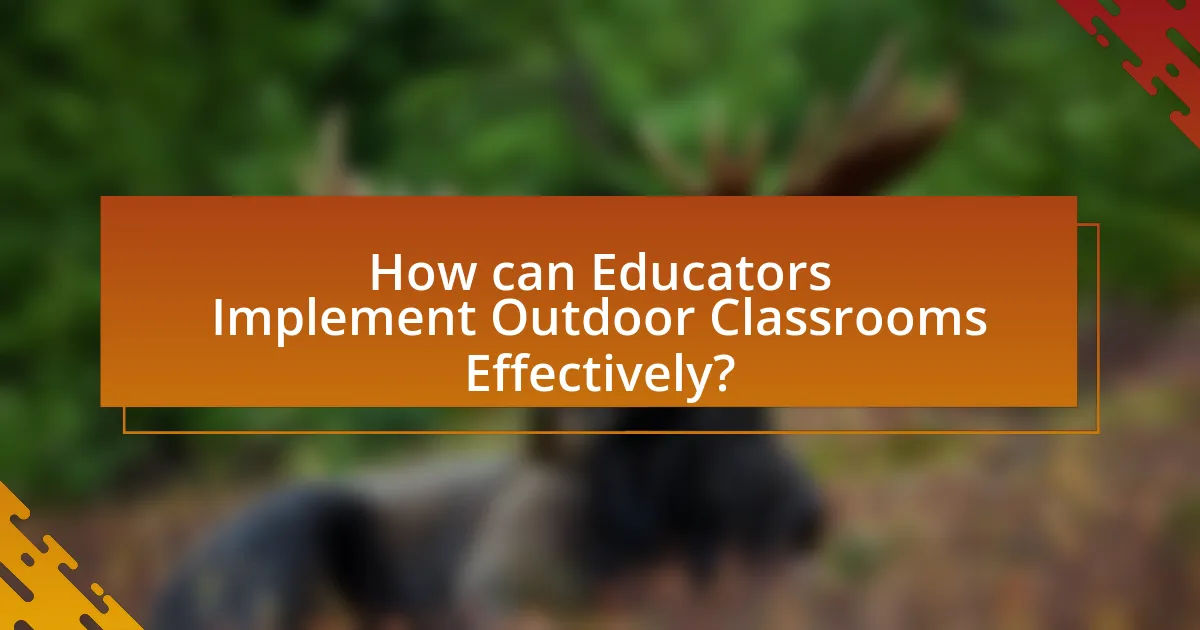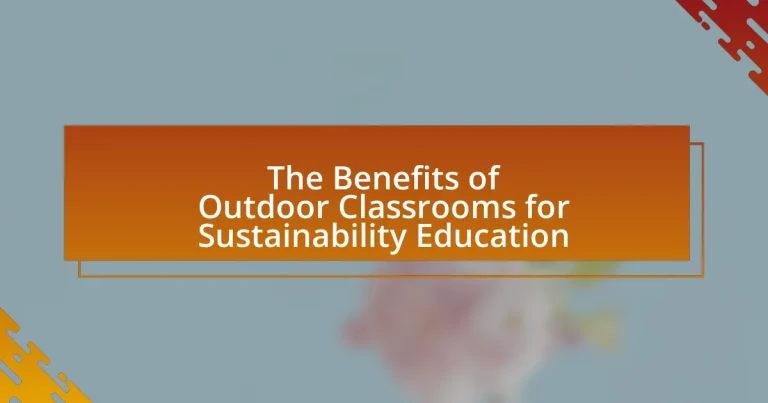Outdoor classrooms are designated outdoor spaces that facilitate experiential learning, particularly in the context of sustainability education. They provide hands-on experiences that enhance student engagement and retention of knowledge related to ecological principles, such as biodiversity and conservation. Research indicates that outdoor classrooms significantly improve students’ attitudes toward the environment and foster collaboration, critical thinking, and social skills. The article explores the unique features of outdoor classrooms, their benefits for sustainability education, and practical strategies for effective implementation, while also addressing potential challenges educators may face in utilizing these environments for learning.

What are Outdoor Classrooms and Their Role in Sustainability Education?
Outdoor classrooms are designated outdoor spaces where educational activities take place, emphasizing experiential learning in natural environments. Their role in sustainability education is significant, as they provide hands-on experiences that foster a deeper understanding of ecological principles and environmental stewardship. Research indicates that outdoor classrooms enhance student engagement and retention of knowledge related to sustainability topics, such as biodiversity, conservation, and climate change. For instance, a study published in the Journal of Environmental Education found that students participating in outdoor learning experiences demonstrated improved attitudes toward the environment and increased awareness of sustainability issues.
How do Outdoor Classrooms differ from Traditional Classrooms?
Outdoor classrooms differ from traditional classrooms primarily in their learning environment, as outdoor classrooms utilize natural settings to facilitate education, while traditional classrooms are confined to indoor spaces. This difference allows outdoor classrooms to promote experiential learning, where students engage directly with their surroundings, enhancing their understanding of ecological concepts and sustainability practices. Research indicates that outdoor learning can improve student engagement and retention of information, as evidenced by a study published in the Journal of Environmental Education, which found that students in outdoor settings demonstrated higher levels of motivation and interest in environmental topics compared to their peers in traditional classrooms.
What unique features do Outdoor Classrooms offer for learning?
Outdoor classrooms offer immersive, hands-on learning experiences that enhance student engagement and understanding of environmental concepts. These unique features include direct interaction with nature, which fosters a deeper appreciation for ecosystems and sustainability. Research indicates that outdoor learning environments improve retention rates by up to 75% compared to traditional classrooms, as students can observe and participate in real-world ecological processes. Additionally, outdoor classrooms promote collaborative learning through group activities, encouraging teamwork and communication skills essential for addressing sustainability challenges.
How do Outdoor Classrooms enhance student engagement?
Outdoor classrooms enhance student engagement by providing immersive, hands-on learning experiences that connect students with nature and real-world applications of their studies. Research indicates that outdoor settings stimulate curiosity and foster a sense of exploration, which can lead to increased motivation and participation in learning activities. For instance, a study published in the Journal of Environmental Education Research found that students in outdoor classrooms demonstrated higher levels of engagement and retention of information compared to traditional indoor settings. This is attributed to the dynamic environment that encourages active learning, collaboration, and critical thinking skills, ultimately making education more relevant and impactful for students.
Why is Sustainability Education Important?
Sustainability education is important because it equips individuals with the knowledge and skills necessary to address environmental challenges and promote sustainable practices. This education fosters critical thinking about resource management, ecological balance, and social equity, which are essential for creating a sustainable future. Research indicates that sustainability education can lead to increased awareness and behavioral changes, as evidenced by a study published in the Journal of Environmental Education, which found that students exposed to sustainability concepts showed a 30% increase in pro-environmental behaviors.
What are the key principles of sustainability education?
The key principles of sustainability education include systems thinking, interdisciplinary learning, and active participation. Systems thinking emphasizes understanding the interconnectedness of ecological, social, and economic systems, which is crucial for addressing complex sustainability challenges. Interdisciplinary learning integrates knowledge from various fields, allowing learners to grasp the multifaceted nature of sustainability issues. Active participation encourages learners to engage in real-world problem-solving and decision-making, fostering a sense of agency and responsibility. These principles are supported by educational frameworks such as the United Nations Educational, Scientific and Cultural Organization (UNESCO) guidelines, which advocate for education that promotes sustainable development through critical thinking and collaborative learning.
How does sustainability education impact future generations?
Sustainability education significantly impacts future generations by fostering environmental awareness and responsible citizenship. This educational approach equips students with the knowledge and skills necessary to address ecological challenges, promoting sustainable practices that can lead to a healthier planet. Research indicates that students exposed to sustainability education are more likely to engage in pro-environmental behaviors, such as recycling and conservation efforts. For instance, a study published in the Journal of Environmental Education found that students who participated in sustainability-focused programs demonstrated a 30% increase in environmentally friendly actions compared to their peers. This foundational understanding of sustainability not only influences individual choices but also cultivates a generation of leaders who prioritize ecological stewardship in their communities and workplaces.

What are the Benefits of Outdoor Classrooms for Sustainability Education?
Outdoor classrooms significantly enhance sustainability education by providing experiential learning opportunities that foster a deeper understanding of environmental concepts. These settings allow students to engage directly with nature, promoting hands-on activities such as gardening, wildlife observation, and ecosystem studies. Research indicates that outdoor learning increases student motivation and retention of information, with studies showing that students in outdoor classrooms perform better in science assessments compared to traditional settings. Furthermore, outdoor classrooms encourage collaboration and critical thinking, essential skills for addressing sustainability challenges. By immersing students in real-world environmental issues, outdoor classrooms cultivate a sense of stewardship and responsibility towards the planet.
How do Outdoor Classrooms promote experiential learning?
Outdoor classrooms promote experiential learning by providing hands-on, real-world experiences that engage students in their environment. This immersive approach allows learners to observe, interact with, and reflect on natural systems, enhancing their understanding of ecological concepts. Research indicates that students in outdoor classrooms demonstrate improved retention of information and greater enthusiasm for learning, as they can directly apply theoretical knowledge in practical settings. For instance, a study published in the Journal of Environmental Education Research found that students participating in outdoor education programs showed a 30% increase in knowledge retention compared to traditional classroom settings.
What types of activities can be conducted in Outdoor Classrooms?
Outdoor classrooms can facilitate a variety of activities, including hands-on environmental science experiments, nature walks, gardening projects, and wildlife observation. These activities promote experiential learning and foster a connection to nature, which is essential for sustainability education. Research indicates that outdoor learning enhances student engagement and retention of knowledge, as demonstrated by a study published in the Journal of Environmental Education, which found that students participating in outdoor activities showed a 20% increase in environmental knowledge compared to traditional classroom settings.
How does hands-on learning in nature enhance understanding of sustainability?
Hands-on learning in nature enhances understanding of sustainability by providing experiential opportunities that connect theoretical concepts to real-world applications. Engaging directly with ecosystems allows learners to observe environmental processes, such as nutrient cycling and biodiversity, fostering a deeper appreciation for ecological interdependence. Research indicates that outdoor education significantly improves students’ environmental literacy, with studies showing that participants in nature-based programs demonstrate increased knowledge of sustainability practices and greater motivation to engage in pro-environmental behaviors. For instance, a study published in the Journal of Environmental Education found that students who participated in outdoor learning experiences exhibited a 30% increase in their understanding of sustainability concepts compared to those who learned in traditional classroom settings.
What social and emotional benefits do Outdoor Classrooms provide?
Outdoor classrooms provide significant social and emotional benefits, including enhanced social skills, improved emotional well-being, and increased engagement among students. Research indicates that outdoor learning environments foster collaboration, communication, and teamwork, as students often work together on projects and activities, which strengthens their social interactions. Additionally, studies show that exposure to nature can reduce stress and anxiety, leading to improved emotional health. For instance, a study published in the Journal of Environmental Psychology found that students in outdoor classrooms reported higher levels of happiness and lower levels of stress compared to traditional indoor settings. These benefits contribute to a more positive learning experience and promote a sense of community among students.
How do Outdoor Classrooms foster teamwork and collaboration?
Outdoor classrooms foster teamwork and collaboration by providing a shared space where students engage in hands-on activities that require collective problem-solving and communication. In these environments, students often participate in group projects, such as building gardens or conducting experiments, which necessitate cooperation and the sharing of ideas. Research indicates that outdoor learning experiences enhance social skills and promote a sense of community among participants, as they work together towards common goals. For instance, a study published in the Journal of Environmental Education found that students in outdoor classrooms demonstrated improved collaboration skills and increased engagement in group tasks compared to traditional classroom settings.
What impact do Outdoor Classrooms have on student well-being?
Outdoor classrooms significantly enhance student well-being by promoting physical activity, reducing stress, and improving mental health. Research indicates that students who engage in outdoor learning experiences exhibit increased levels of happiness and reduced anxiety. A study published in the International Journal of Environmental Research and Public Health found that outdoor education positively affects students’ emotional well-being, with 90% of participants reporting improved mood and focus after outdoor lessons. Additionally, exposure to natural environments has been linked to lower levels of cortisol, a stress hormone, further supporting the positive impact of outdoor classrooms on student well-being.

How can Educators Implement Outdoor Classrooms Effectively?
Educators can implement outdoor classrooms effectively by designing structured, curriculum-aligned activities that leverage the natural environment for hands-on learning experiences. This approach enhances student engagement and fosters a deeper understanding of sustainability concepts. Research indicates that outdoor learning can improve academic performance; for instance, a study by the University of Illinois found that students who participated in outdoor education scored higher in science assessments compared to their peers in traditional classrooms. Additionally, educators should ensure safety and accessibility by selecting appropriate outdoor spaces and providing necessary resources, such as seating and materials, to facilitate learning. By integrating outdoor classrooms into the curriculum, educators can promote environmental stewardship and encourage students to connect with nature, ultimately supporting sustainability education.
What are the best practices for designing an Outdoor Classroom?
The best practices for designing an outdoor classroom include selecting a suitable location, ensuring accessibility, incorporating natural elements, and providing flexible seating arrangements. A suitable location should be away from noise and distractions, ideally with ample sunlight and shade. Accessibility is crucial, as pathways should accommodate all students, including those with disabilities. Incorporating natural elements, such as trees, gardens, and water features, enhances the learning environment and fosters a connection to nature. Flexible seating arrangements, such as benches, logs, or movable chairs, allow for various teaching styles and group activities. Research indicates that outdoor classrooms can improve student engagement and learning outcomes, as evidenced by studies showing increased attention and retention in outdoor settings.
How can educators integrate curriculum with Outdoor Classroom activities?
Educators can integrate curriculum with Outdoor Classroom activities by aligning lesson plans with outdoor experiences that reinforce academic concepts. For instance, science lessons on ecosystems can be taught through hands-on exploration of local habitats, allowing students to observe biodiversity directly. Research indicates that outdoor learning enhances student engagement and retention; a study by the University of Illinois found that students who participated in outdoor education showed improved academic performance and increased motivation. By incorporating outdoor activities that relate to the curriculum, educators can create a dynamic learning environment that fosters both academic and environmental awareness.
What resources are available for creating Outdoor Classrooms?
Resources available for creating outdoor classrooms include educational grants, community partnerships, and curriculum guides. Educational grants, such as those from the National Environmental Education Foundation, provide funding specifically for outdoor learning initiatives. Community partnerships with local organizations, such as parks and environmental groups, can offer support and resources for outdoor classroom development. Additionally, curriculum guides from organizations like the North American Association for Environmental Education provide structured frameworks for integrating sustainability education into outdoor settings. These resources collectively enhance the effectiveness and accessibility of outdoor classrooms, promoting sustainability education.
What challenges might educators face when using Outdoor Classrooms?
Educators may face several challenges when using outdoor classrooms, including weather-related disruptions, logistical issues, and safety concerns. Weather can impact lesson plans, as rain or extreme temperatures may limit outdoor activities. Logistically, educators must manage resources such as materials and technology that may not be readily available outside, complicating lesson execution. Additionally, safety concerns arise from the outdoor environment, including potential hazards like uneven terrain or wildlife, which require careful supervision and planning to ensure student safety. These challenges can hinder the effectiveness of outdoor classrooms in delivering sustainability education.
How can weather and environmental factors affect Outdoor Classroom activities?
Weather and environmental factors significantly influence Outdoor Classroom activities by determining the feasibility and safety of outdoor learning experiences. For instance, extreme temperatures can lead to discomfort or health risks for students and educators, while precipitation can disrupt planned activities and limit outdoor engagement. Research indicates that adverse weather conditions, such as heavy rain or strong winds, can lead to cancellations of outdoor lessons, thereby reducing the effectiveness of experiential learning opportunities. Additionally, environmental factors like air quality and noise pollution can impact students’ ability to concentrate and engage with the curriculum, ultimately affecting their learning outcomes.
What strategies can be employed to overcome logistical challenges?
To overcome logistical challenges in outdoor classrooms for sustainability education, implementing a structured planning approach is essential. This includes conducting thorough site assessments to identify potential obstacles such as weather conditions, accessibility, and resource availability. For instance, a study by the National Outdoor Classroom Network highlights that schools that plan for diverse weather conditions and have contingency plans in place can effectively minimize disruptions. Additionally, establishing partnerships with local organizations can provide necessary resources and support, enhancing the educational experience while addressing logistical hurdles.
What are some practical tips for maximizing the benefits of Outdoor Classrooms?
To maximize the benefits of Outdoor Classrooms, educators should integrate hands-on, experiential learning activities that connect students with nature. Engaging students in activities such as gardening, wildlife observation, and environmental monitoring fosters a deeper understanding of ecological concepts. Research indicates that outdoor learning can enhance student engagement and retention of information, with studies showing that students in outdoor classrooms demonstrate improved academic performance and social skills. Additionally, incorporating local environmental issues into the curriculum can make learning more relevant and impactful, as evidenced by programs that link classroom lessons to community sustainability projects.


